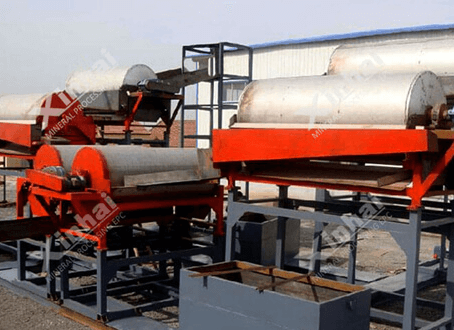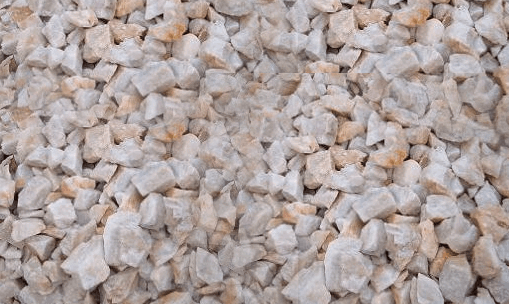Main Equipment
More
Withdraw

Silica sand processing technology is mainly purification, to remove small or trace amount of impurities. It is a difficult separation technology to recover refined silica sand and high purity silica sand.
Silica sand processing technologies include impurity analysis and removal process and purification process, etc.
More
Withdraw
Through crushing, grinding, and classification, natural silica sandstone mine is ground. The impurities and minerals reach dissociation monomer separation. Then, through classification, raw silica sand with qualified particle size, which is the preparation for later purification.

Jaw crusher is used to crush natural silica sandstone into pieces. Then, wet grinding is carried out in grinding equipment to require silica sand with smaller particle size. The wet grinding can remove the dust produced in grinding and attached impurities (such as iron oxides and hydroxides) through rubbing against each other. Then, grinding products enter classification operation. The silica sands with qualified particle size enter purification as silica sand raw ore. The coarse particles return to the grinding stage.
Through scrubbing and desliming, magnetic separation, chute gravity separation, flotation, scouring or combined process, the impurities are removed from silica sand. The high purity silica sand with qualified particle size and impurity content can be required.
Depending on the mechanical force and grinding force, the thin film iron, bond and muddy impurities can be removed. Further smash the unconstituted mineral aggregates, and then perform the classification operation to further purify the silica sand.
Magnetic separation is an effective way to remove the iron impurities. Because the hematite, limonite, biotite and other minerals has weak magnetic, they can be separated under 8×105A/m in wet magnetic separator. And for impurities mainly as magnetite, weak magnetic separator or middle magnetic separator can be used. To remove small amount of weak magnetic minerals furtherly(such as hornblende, pyroxene, and the concatenation of magnetic minerals and quartz), a high-gradient magnetic separator with a magnetic field strength greater than 12000 Gauss can be used for secondary magnetic separation.
When the raw material contains a very small amount of heavy mineral impurities (such as zircon), because it is not magnetic and has a specific weight greater than quartz, the spiral chute gravity separation method can be used to effectively remove such heavy mineral impurities. When the raw mortar body rotates and slides along the spiral chute surface, various minerals will be separated under the dual action of gravity and centrifugal force according to their respective specific gravity.
The greater the difference in the specific gravity of the minerals, the higher the degree of separation. It is worth noting that the mineral morphology also has a certain influence on the sorting of spiral chute, and flake minerals are easier to separate from granular minerals. Therefore, when the spiral chute is used to sort the raw quartz mortar, the sorted quartz mortar can be divided into three parts: granular heavy mineral area, granular silica sand area, and flaky mineral and light mineral area. While using the spiral chute to remove the heavy minerals in the silica sand, it can also remove part of the flake-shaped mica minerals.
If there are many kinds of mica minerals in the raw materials, it is impossible to completely remove the impurities by only using the spiral chute. In addition, if the raw material still contains a certain amount of feldspar minerals with a specific gravity similar to that of quartz, the flotation process can be used to remove these impurity minerals. At the same time, when quartz minerals and gangue minerals do not reach a certain degree of monomer dissociation, it is necessary to increase the fineness of grinding.
A three-stage flotation process is used to remove mica minerals and feldspar minerals in the silica sand. The first-level flotation is in a neutral or weakly acidic environment, and the corresponding reagent system is used to flotate iron-containing mud from the slurry; the second-level flotation is in a neutral or weakly acidic environment, and the corresponding Reagent system flotation flotation of mica minerals and concatenation of mica and quartz from the slurry; tertiary flotation is to flotate feldspar minerals from the slurry in a neutral or weakly acidic environment. And the conjoined body of feldspar and quartz.
If the finished quartz sand or the product quartz sand after the removal and selection operation is reddish, and the iron and titanium content is too high to meet the product quality requirements, the pickling method can be used, first washing to remove powder and impurities, then pickling soaking and washing, and finally Dry or let dry.
Silica sand ore in a certain place in Yunnan, the main component is quartz, accounting for 95-97%, siliceous cement accounts for 8-23%, and the impurity minerals are mainly hematite, limonite, etc., accounting for about 1-3%. The original beneficiation plant adopted sieving and classification-dry magnetic separation-strong scrubbing with chemicals-and the final SiO2 ≥ 97.62%, Fe2O3 ≤ 0.24, Al2O3 ≤ 1.11%, poor indicators, seriously affecting the company's production indicators and economic benefits. Therefore, the concentrator entrusted Xinhai to carry out the technical transformation. Through the process, Xinhai decided to adopt the beneficiation process of screening and grading-dry magnetic separation-dosing strong scrubbing-acid leaching, and the quality index of the refined sand obtained is excellent.
| Compared Before and After Transformation | Processing Technology | Concentration Indexes |
|---|---|---|
| Before | Screening and classification – dry magnetic separation – dosing strong scrubbing - flotation | SiO2≥97.62%,Fe2O3≤0.24,Al2O3≤1.11% |
| After | Screening and classification – dry magnetic separation – dosing strong scrubbing – acid leaching | SiO2≥99.4%,Fe2O3≤0.052,Al2O3≤0.048% |
After transformation, the chemical composition of silica sand meets the quality requirements of silica powder after purification,, and can be used in ceramics, coatings, metal casting and other industries after ultra-fine grinding.
Please leave your message here! We will send detail technical info and quotation to you!
